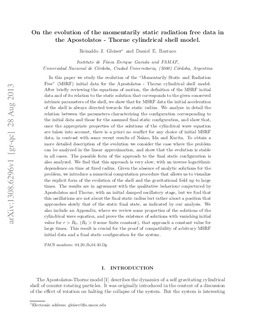| dc.contributor.author | Gleiser, Reinaldo Jaime | |
| dc.contributor.author | Barraco, Daniel Eugenio | |
| dc.date.accessioned | 2022-08-24T16:00:24Z | |
| dc.date.available | 2022-08-24T16:00:24Z | |
| dc.date.issued | 2014-02-24 | |
| dc.identifier.uri | http://hdl.handle.net/11086/28294 | |
| dc.description.abstract | In this paper we study the evolution of the 'Momentarily Static and Radiation Free' (MSRF) initial data for the Apostolatos–Thorne cylindrical shell model. After briefly reviewing the equations of motion, the definition of the MSRF initial data and of its relation to the static solution that corresponds to the given conserved intrinsic parameters of the shell, we show that for MSRF data the initial acceleration of the shell is always directed towards the static radius. We analyse in detail the relation between the parameters characterizing the configuration corresponding to the initial data and those for the assumed final static configuration, and show that, once the appropriate properties of the solutions of the cylindrical wave equation are taken into account, there is a priori no conflict for any choice of initial MSRF data, in contrast with some recent results of Nakao, Ida and Kurita. To obtain a more detailed description of the evolution we consider the case where the problem can be analysed in the linear approximation, and show that the evolution is stable in all cases. The possible form of the approach to the final static configuration is also analysed. We find that this approach is very slow, with an inverse logarithmic dependence on time at fixed radius. Given the absence of analytic solutions for the problem, we introduce a numerical computation procedure that allows us to visualize the explicit form of the evolution of the shell and the gravitational field up to large times. The results are in agreement with the qualitative behaviour conjectured by Apostolatos and Thorne, with an initial damped oscillatory stage, but we find that these oscillations are not about the final static radius but rather about a position that approaches slowly that of the static final state, as indicated by our analysis. We also include one appendix, where we review some properties of the solutions of the cylindrical wave equation, and prove the existence of solutions with vanishing initial value for r > R0, (R0 > 0 some finite constant), that approach a constant value for large times. This result is crucial for the proof of compatibility of arbitrary MSRF initial data and a final static configuration for the system. In a second appendix we discuss in detail the reasons for the discrepancy between our results and some aspects of the related work by both Apostolatos and Thorne, and by Nakao, Ida and Kurita. | es |
| dc.description.uri | http://iopscience.iop.org/0264-9381/31/6/065003 | |
| dc.format.medium | Impreso; Electrónico y/o Digital | |
| dc.language.iso | eng | en |
| dc.relation.uri | https://doi.org/10.1088/0264-9381/31/6/065003 | en |
| dc.rights | Attribution-NonCommercial-NoDerivatives 4.0 International | * |
| dc.rights.uri | http://creativecommons.org/licenses/by-nc-nd/4.0/ | * |
| dc.source | ISSN: 0264-9381 | en |
| dc.source | e- ISSN: 1361-6382 | en |
| dc.subject | General Relativity | en |
| dc.subject | Thin Shells | en |
| dc.subject | Cylindrical Symmetry | en |
| dc.subject | Radiation | en |
| dc.subject | Cylindrical | en |
| dc.subject | Shell | en |
| dc.title | On the evolution of the momentarily static radiation free data in the Apostolatos - Thorne cylindrical shell model | en |
| dc.type | article | en |
| dc.description.version | SubmittedVersion | en |
| dc.description.fil | Fil: Gleiser, Reinaldo Jaime. Universidad Nacional de Córdoba. Facultad de Matemática, Astronomía y Física; Argentina. | es |
| dc.description.fil | Fil: Gleiser, Reinaldo Jaime. Universidad Nacional de Córdoba. Instituto de Física Enrique Gaviola; Argentina. | es |
| dc.description.fil | Fil: Gleiser, Reinaldo Jaime. Consejo Nacional de Investigaciones Científicas y Técnicas. Instituto de Física Enrique Gaviola; Argentina. | es |
| dc.description.fil | Fil: Barraco, Daniel Eugenio. Universidad Nacional de Córdoba. Facultad de Matemática, Astronomía y Física; Argentina. | es |
| dc.description.fil | Fil: Barraco, Daniel Eugenio. Universidad Nacional de Córdoba. Instituto de Física Enrique Gaviola; Argentina. | es |
| dc.description.fil | Fil: Barraco, Daniel Eugenio. Consejo Nacional de Investigaciones Científicas y Técnicas. Instituto de Física Enrique Gaviola; Argentina. | es |
| dc.journal.city | Londres | es |
| dc.journal.country | Reino Unido | es |
| dc.journal.editorial | IOP Publishing | es |
| dc.journal.number | 6 | es |
| dc.journal.pagination | 1-26 | es |
| dc.journal.referato | Con referato | |
| dc.journal.title | Classical and Quantum Gravity | en |
| dc.journal.volume | 31 | es |
| dc.description.field | Física de Partículas y Campos | |
| dc.identifier.doi | https://doi.org/10.48550/arXiv.1308.6296 | en |





